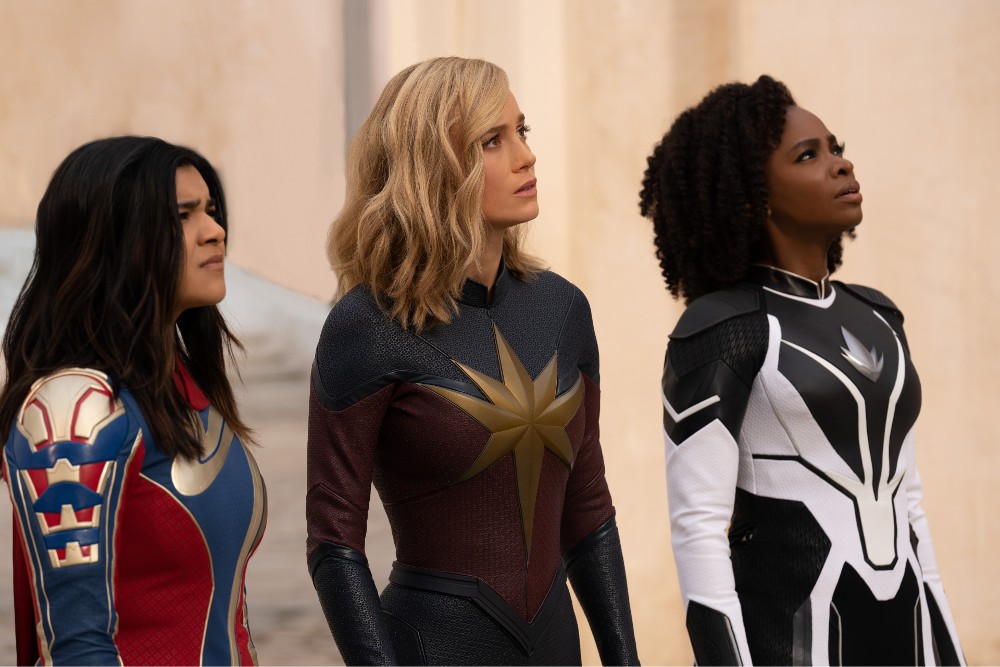
So much has happened since we first met Brie Larson as Carol Danvers, the tough as nails Airforce pilot who becomes the titular Avenger. Most importantly, in her upcoming film The Marvels, she has grown past her wobbly origin story and into a bond with two other impressive women who make her temporary team. The end result is a highly entertaining comic book film that works for the most part, and that may save not just the fictional galaxy it inhabits but also the deeply in trouble Marvel Cinematic Universe.
The origin film, Captain Marvel, came out only four years ago—a whole eon in movies given the pandemic and other developments—but the story actually took place in 1995. That film suffered from all the expository blues and cliches of an origin film, including that it felt forced and just a bridge to something bigger.
Enter Danvers again, this time accompanied by Astronaut Monica Rambeau (Teyonah Parris), the daughter of a character who was a pilot with a younger Danvers in the first film, and teenager Kamala Kahn (Iman Vellani). Freed from the bonds of having to set up a story, The Marvels works a lot better than its narrative predecessor. And with the much more affable Captain Rambeau and Kamala, or Ms. Marvel as she becomes known, joining the crew, the movie is a lot more likeable, too.
In this film, a furious warrior named Dar-Benn (Zawe Ashton) seeks personal revenge against Captain Marvel for the sufferings of her people, the Kree, who had at some point in the past been freed from computer enslavement by Danvers herself. It is amusing to recall that the villain in the first film was an A.I. bot, before that was a cool thing to villainize in films, but it and many of the other details from the prior picture are also a tad confusing. MCU fans will no undoubtedly have no trouble following all of this, but for the rest of us mere mortals a brief sojourn through the Captain Marvel Wikipedia page is highly advised.
In any event, Dar-Benn is pissed and she posses a Thor-like hammer that permits her to open portals between dimensions. She also has a mysterious bracelet that is, like so many other things in the superhero world, incomplete without another piece. This time around, that piece is a similar bracelet that is inexplicably around the wrist of Ms. Marvel herself, making her both an obvious target but also foil. Dar-Benn goes around planets destroying them Death Star-style to save her own. Meanwhile, the bridges between dimensions she has opened has also inexplicably connected the three heroines, all of which have some superpower related to light.
A lot of this is narratively glossed over by writer/director Nia DaCosta’s script, which she co-wrote with Megan McDonnell and Elissa Karasik. Captain Rambeau, for instance, was as a child very close to Danvers. Nearly thirty years have passed though, and little has been said between them, until the events of this movie. Given everything else that happens in this cinematic universe, this makes no sense. Nor does the fact that Ms. Marvel has the powers she does.
The lack of endless exposition though, as disorienting as it is, soon gives way to a better time. The crux of the problem is simple and complicated. Dar-Benn is traveling from planet to planet seeking revenge with her purple eyes, fearsome makeup and jewelry, and mighty staff or hammer. Our tireless threesome just need to follow, find, and fight her—and they do this very well. It is also complicated in the sense that the three heroines now switch places automatically when two or more are using their given powers at the same time. This leads to some playful editing by Catrin Hedstrom near the outset of the film, but also a sequence of confusing fight sequences. This persists until the trio perfects the art of only tele transporting into each other purposefully, but by this point that trick is never really exploited to further the plot.
But it is in that simplicity that the entertainment value of this film lies. It is all relative of course, in this convoluted universe, but gone as the confounding time twists, the reversals, the feelings that nothing is ever in danger. While we know that to be the case here, the fact that this is a middle story permits there to be a little more stakes, a little more dying, a little less “everything returns to normal.”
The icing on the cake is a delightful sequence that has the three heroines travel to the planet Aladna whose charming Prince Yan (Park See-joon) is secretly married to Danvers and whose people only speak in song (and dance). The costumes, the cinematography, the set design of this jewel of a town somewhere in space is the best moment both production-wise and story-wise for The Marvels, and sets it aside from so many others who had defaulted so much to VFX reliance.
The Marvels overcomes all these structural weights to produce an entertaining film that does not try to bite too much and rush towards the next big thing. Captain Marvel remains not a particularly exciting hero, but her delightful team bring out the best in her and Larson this time. The end result is nothing short of marvelous entertainment.
Grade: B+
The Marvels will be released by Marvel Studios / Walt Disney Studios on November 17, 2023.
Twitter: @jdonbirnam
Instagram: @awards_predix





